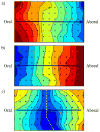Mapping small intestine bioelectrical activity using high-resolution printed-circuit-board electrodes
- PMID: 22255449
- PMCID: PMC4076342
- DOI: 10.1109/IEMBS.2011.6091227
Mapping small intestine bioelectrical activity using high-resolution printed-circuit-board electrodes
Abstract
In this study, novel methods were developed for the in-vivo high-resolution recording and analysis of small intestine bioelectrical activity, using flexible printed-circuit-board (PCB) electrode arrays. Up to 256 simultaneous recordings were made at multiple locations along the porcine small intestine. Data analysis was automated through the application and tuning of the Falling-Edge Variable-Threshold algorithm, achieving 92% sensitivity and a 94% positive-predictive value. Slow wave propagation patterns were visualized through the automated generation of animations and isochronal maps. The methods developed and validated in this study are applicable for use in humans, where future studies will serve to improve the clinical understanding of small intestine motility in health and disease.
Figures




Similar articles
-
Experimental and Automated Analysis Techniques for High-resolution Electrical Mapping of Small Intestine Slow Wave Activity.J Neurogastroenterol Motil. 2013 Apr;19(2):179-91. doi: 10.5056/jnm.2013.19.2.179. Epub 2013 Apr 16. J Neurogastroenterol Motil. 2013. PMID: 23667749 Free PMC article.
-
Circumferential and functional re-entry of in vivo slow-wave activity in the porcine small intestine.Neurogastroenterol Motil. 2013 May;25(5):e304-14. doi: 10.1111/nmo.12085. Epub 2013 Mar 12. Neurogastroenterol Motil. 2013. PMID: 23489929 Free PMC article.
-
Falling-edge, variable threshold (FEVT) method for the automated detection of gastric slow wave events in high-resolution serosal electrode recordings.Ann Biomed Eng. 2010 Apr;38(4):1511-29. doi: 10.1007/s10439-009-9870-3. Epub 2009 Dec 19. Ann Biomed Eng. 2010. PMID: 20024624 Free PMC article.
-
Automated detection of gastric slow wave events and estimation of propagation velocity vector fields from serosal high-resolution mapping.Annu Int Conf IEEE Eng Med Biol Soc. 2009;2009:2527-30. doi: 10.1109/IEMBS.2009.5334822. Annu Int Conf IEEE Eng Med Biol Soc. 2009. PMID: 19964973 Free PMC article.
-
Printed Circuit Board (PCB) Technology for Electrochemical Sensors and Sensing Platforms.Biosensors (Basel). 2020 Oct 30;10(11):159. doi: 10.3390/bios10110159. Biosensors (Basel). 2020. PMID: 33143106 Free PMC article. Review.
Cited by
-
Automated algorithm for GI spike burst detection and demonstration of efficacy in ischemic small intestine.Ann Biomed Eng. 2013 Oct;41(10):2215-28. doi: 10.1007/s10439-013-0812-8. Epub 2013 Apr 24. Ann Biomed Eng. 2013. PMID: 23612912 Free PMC article.
-
Characteristics of Intestinal Myoelectrical and Motor Activities in Diet-Induced Obese Rats: Obesity and Motility.Dig Dis Sci. 2019 Jun;64(6):1478-1485. doi: 10.1007/s10620-019-5458-4. Epub 2019 Jan 19. Dig Dis Sci. 2019. PMID: 30659469
-
Experimental and Automated Analysis Techniques for High-resolution Electrical Mapping of Small Intestine Slow Wave Activity.J Neurogastroenterol Motil. 2013 Apr;19(2):179-91. doi: 10.5056/jnm.2013.19.2.179. Epub 2013 Apr 16. J Neurogastroenterol Motil. 2013. PMID: 23667749 Free PMC article.
-
Circumferential and functional re-entry of in vivo slow-wave activity in the porcine small intestine.Neurogastroenterol Motil. 2013 May;25(5):e304-14. doi: 10.1111/nmo.12085. Epub 2013 Mar 12. Neurogastroenterol Motil. 2013. PMID: 23489929 Free PMC article.
-
The virtual intestine: in silico modeling of small intestinal electrophysiology and motility and the applications.Wiley Interdiscip Rev Syst Biol Med. 2016 Jan-Feb;8(1):69-85. doi: 10.1002/wsbm.1324. Epub 2015 Nov 12. Wiley Interdiscip Rev Syst Biol Med. 2016. PMID: 26562482 Free PMC article. Review.
References
-
- Huizinga JD, Lammers WJ. Gut peristalsis is governed by a multitude of cooperating mechanisms. Am J Physiol Gastrointest Liver Physiol. 2009;296(1):G1–8. - PubMed
-
- Seidel SA, Hegde SS, Bradshaw LA, Ladipo JK, Richards WO. Intestinal tachydysrhythmias during small bowel ischemia. Am J Physiol. 1999;277:G993–9. - PubMed
-
- You CH, Chey WY, Lee KY, Menguy R, Bortoff A. Gastric and small intestinal myoelectric dysrhythmia associated with chronic intractable nausea and vomiting. Ann Intern Med. 1981;95:449–451. - PubMed
-
- Morrison P, Miedema BW, Kohler L, Kelly KA. Electrical dysrhythmias in the Roux jejunal limb: cause and treatment. Am J Surg. 1990;160:252–256. - PubMed
-
- Alvarez W, Mahoney L. Action currents in stomach and intestine. Am J Physiol. 1922;58(3):476–493.
Publication types
MeSH terms
Grants and funding
LinkOut - more resources
Full Text Sources
